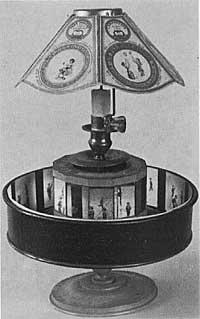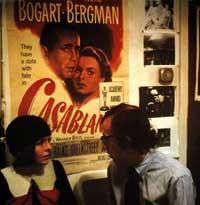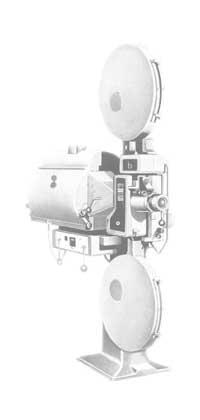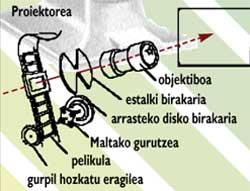100 years also cinema
Elhuyar Fundazioa
The image generated in the retina of the eye persists for a short period of time (1/10 to 1/5 s). This phenomenon is the essence of the optical illusion generated by cinematography. Illuminating the photos made at the same speed as those taken, before the image disappears from the retina the next image is formed and the view receives a feeling of continuous movement.

When the British physician Peter Mark Roget (1779-1869) presented the thesis of this phenomenon, several inventors began to build apparatus to replace the optical perception of motion: The fenacistiscope of the Belgian physicist Joseph Plateau (1801-1883) in 1983, the zootrope of William George Horner (1786-1837) in 1834 and 1877, the praxinoscope of the Frenchman Emile Reynaud, who perfected and perfected all of them, are witnesses of this environment.
All these devices used drawings and not photographs, although photography was an invention of the public since 1839. In 1874 the director of the observatory of Meudón, the French Pierre Jausseu (1824-1907), invented the astronomical revolver to analyze the displacement of Venus in front of the sun; the successive phases of this movement were photographically impressed on a circular sheet that turned in front of a target, overcoming the previous steps.
The French physiologist Etienne-Jules Marey (1830-1904), based on the same principle, studied the movements of animals and men using the photographic rifle; influenced by the cat, managed to take 12 consecutive photos (exhibition 1/720 s). At the same time, the British photographer Edward Muybridge (1830-1904) investigated the recording in images of the movement of animals through independent cameras.
However, all these experiences sought to analyze or decompose the movement in photographs and not synthesize or reconstruct it optically.
Redoubling the work of pioneers

Tomás Alva Edison (1847-1931) tried it in the United States. In his works he used a flexible film of 35 mm long celluloid perforated by hay. As we know, the format followed by the film industry was the same.
A film that was a breakthrough and in 1891 patented the kinetoscope, a device to watch films individually. However, the first film screening on a screen and in public was made by the brothers Louis (1864) and Auguste (1862 1954) Lumière on 28 December 1895, successful in the public presentation of the cinematographer in Paris (image of entry to this article). The cinematograph was a tool that combined camera and projector. It has been 100 years since then and that fact is considered the creation of cinema. This fact is also the reason that has led us to write these lines.
Cinema created
These first images reflected everyday life, such as the arrival of a train, the departure of workers from a factory, etc., but the cinema was soon released to the screen.
Georges Méliès (1861-1938), editor and producer, is the first great prestige of cinema. He was the first to use scripts and most of the exchanges used by current cinema are based on their inventions and experiments. Between 1896 and 1913 he produced 500 films in which he served as director, scenographer, operator and even actor.
Foundations of cinematographic language (that is, the rapidity of the story, the changes of situation, the spatial and temporal leaps, the organization through plans, sequences and scenes) XX. They were consolidated in the early years of the twentieth century, W. Thanks especially to the works of Griffit, but to the German expressionists (F. Lang, F.W. Murnau) and Soviet filmmakers (S. Eisenstein, V. Pudovkin, et.en) too.

By then the film industry had already begun to develop in the US. The important area of this first soundless “mute” cinema was comedy, with Charles Chaplin, Buster Keaton and Harold Lloyd as main stars. When in 1927 sound and image were integrated into the film, the film revolution had not been made until then, a new era was opened. Alan Crosland’s “Kantarian Jazz” opened the door to this new era. The use of sound meant the expansion of the framework of expressive resources of cinema (sound effects, musical cinema, dialogue, etc.) All this was a great success of cinema as a show and as a means of artistic expression.
During World War II, the world of cinema was dominated by Hollywood studios, which were often characterized by the mere film production industry (so we should analyze the trend from the current situation). From this time some directors and films have become film classics, such as J. Renoir, E. Lubitsch, H. Hawks, J. Ford and O. Welles: they are the big names that can be found in the black and white era. In 1935 the first color film was shot, but it took twenty more years to generalize it.
During the war and in the years that followed, numerous war films were shot in Hollywood, and it can often be said that they had an exclusively propagandistic goal, when American studios reached their highest level. From there emerged a strong competitor at the show level: television.
Worldwide film market

On the other hand, in many countries film production began to be strengthened and diversified, creating directors and independent groups. The charm of cinema spread rapidly to Europe, where the most important schools were Italian neorealism and French nouvelle vague.
Meanwhile, new resources are beginning to be integrated. This shows that cinema has been an honest customer of science and technology and, for example, in the 1980s it began to use film video and computer animation.
Cinema in Euskal Herria
The movement that was spreading around the world in the form of fever did not remain at the gates of Euskal Herria. However, until 1928 no Basque production was projected: M. Azkona's premute film broke borders. However, until 1968 no films were produced in Euskal Herria ( Ama Lur, N. Basterretxea and F. Larrukert). The documentary series Ikuska was produced between 1979 and 1983.
It can be said that the new era of Basque cinema began in 1981; the blame, more merit, is Imanol Uribe, “La fuga de Segovia”. Since then several films have been made in Basque: Reporters (I. Aizpuru, 1884), Sixteen Aidanez (A. Lertxundi), One hundred meters (A. Ungria, 1985), Zergatik Panpox (X. Elorriaga, 1985), from Karel (A. Lertxundi, 1987), De memento sin nombre (J.J. Bakedano, 1987), Days between Fumes (A. Ezeiza, 1988), among others.
Processing process
The process of making the film begins with taking a view or shooting. The basic tool used for this is the film camera, which is a photo camera, but the film passes in front of the lens at a certain speed. An engine emits impulses to the drag system that periodically pulls the film through the side holes. Therefore, the film does not move continuously, but advances at regular intervals and stops at other times.

Each time it is left, the film is exposed to light (a frame is printed) and when moving, a swivel cover covers the lens to prevent light from passing. The shooting speed in normal cameras is 24 frames per second. At the time of silent cinema the frame was 16 seconds.
The sound is recorded by a special camera or a microphone synchronized with the camera. It can also be recorded directly with the view receiver, using an optical or magnetic track. Commercial films usually record several soundtracks. One with interviews, another with music, another with special effects, etc. In some cases it has been used more than ten bands, although with a maximum of four.
Once the film is revealed in the laboratory, a copy of the film is obtained and the unnecessary material is disregarded. In commercial films it is considered normal to take advantage of 10% of everything filmed. Once the assembly is done the dubbing, the sound assembly (image and sound synchronization) and the mixes (coordination of different soundtracks). Once these operations are performed, the original negative of the film is ordered according to the copy resulting from the mentioned operations and copies are made.

The final result is seen thanks to the projector. A powerful light passes through frames projecting images on the screen. The projector's drag system is similar to the receiving view and should be projected at the same shooting speed (usually 24 frames per sengundo).
But filming can be done at other speeds. The so-called slow motion, for example, the feeling of slowness or cunning of the movements that the viewer receives, is the result of a shoot made at a speed greater than 24 frames per conventional second. On the contrary, if the shooting speed was reduced, very fast movements would be printed. With this latter system, for example, we can appreciate the slow growth of a flower.





